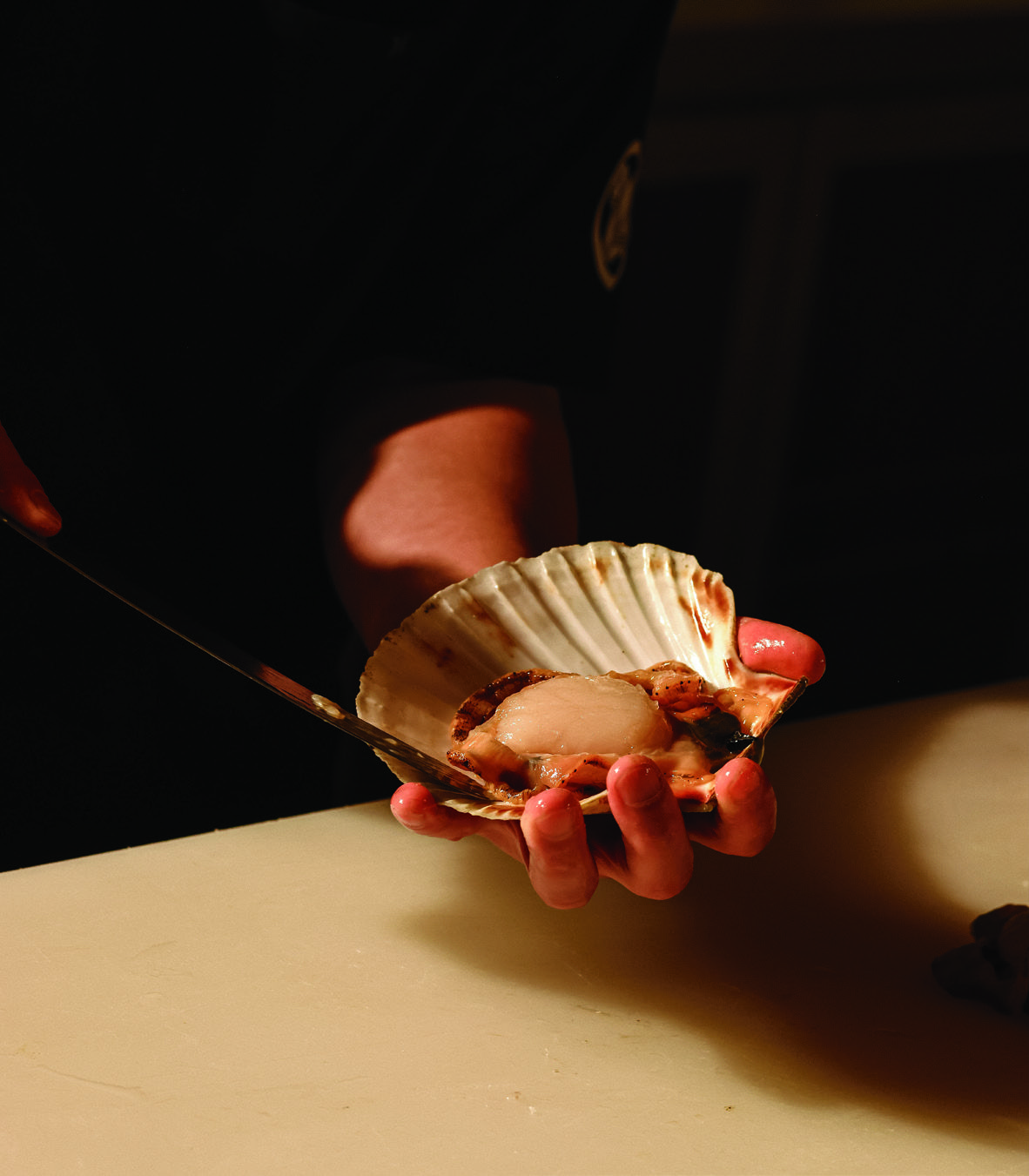แม้จะเป็นร้านอาหารที่แพงที่สุดในลอนดอน แต่ Sushi Kanesaka กลับซ่อนตัวอยู่ในมุมลับๆ ร้านตั้งตั้งอยู่ในย่าน Mayfair ภายในโรงแรม 45 Park Lane แต่กลับไร้ป้ายบอกทางใดๆ สร้างความสับสนให้กับผู้คนที่เดินผ่านไปมา แถมทางเข้าร้านยังอยู่ด้านหลังห้องส่วนตัวใน Bar 45 ของโรงแรมอีกต่างหาก บรรยากาศภายในบาร์นั้นมืดทึม ตกแต่งสไตล์อิตาบางยุค 50 ตัดกับภาพของ okami-san ชาวญี่ปุ่นในชุดดั้งเดิม ผู้กำลังเตรียมอาหารสำหรับมื้อค่ำ ซึ่งยิ่งทำให้ลูกค้าที่มาดื่มที่บาร์อดสงสัยไม่ได้ว่า เครื่องดื่ม Negroni ของพวกเขาผสมอะไรลงไปบ้าง

แต่ร้านไม่จำเป็นต้องมีป้ายโฆษณาชวนลูกค้าเดินผ่านไปมาเพื่อดึงดูดความสนใจ เพราะที่นี่รับลูกแค่เพียงแค่ 9 ที่นั่งเท่านั้น และเมนูเซ็ตมีราคาแพงถึง £420 (ประมาณ $530) เชฟชินจิ Kanesaka เจ้าของร้าน มีดาวมิชลินถึงสองดวงจากร้านอาหารในโตเกียวที่ขึ้นชื่อเรื่องความพิเศษ เขายังมีสาขาอื่นๆ ในญี่ปุ่น สิงคโปร์ และฮ่องกง สำหรับสาขาลอนดอนแห่งนี้ ถือเป็นสาขาแรกนอกทวีปเอเชีย และได้รับรางวัลดาวมิชลินเป็นของตัวเองในเดือนกุมภาพันธ์ ทั้งที่เพิ่งเปิดร้านได้เพียงเจ็ดเดือนเท่านั้น แม้ว่าร้านอาหารอื่น ๆ ในลอนดอนจะมีเมนูเด็ดราคาแพงลิบรายการเดียว เช่น เนื้อวากิวโทมาฮอว์ก ราคาประมาณ $800 ที่ร้าน Nusr-Et แต่เมนูเซ็ต 18 คอร์สของร้าน Kanesaka ถือเป็นเมนูที่แพงที่สุดในสหราชอาณาจักร โดยหากเลือกจับคู่กับสาเก ก็จะยิ่งเพิ่มราคาอีกประมาณ $180
เชฟ Kanesaka เดินทางมาลอนดอนเพียงไม่กี่วัน ก่อนช่วงเวลาที่จะได้รับรางวัลดาวมิชลิน เขาเตรียมเมนู omakase ให้กับเชฟมิชลินสตาร์ท่านอื่น ๆ ของลอนดอน และแขกผู้มีเกียรติบางท่าน รวมถึง Robb Report แม้ว่าลูกค้าชาวลอนดอนจะพลาดโอกาสลิ้มลองฝีมือเชฟชื่อดังระดับโลก ปรุงซูชิสดๆ ที่ร้านหรูย่าน Mayfair แต่บรรยากาศภายในร้านอาหารของโรงแรม (สมมติว่าคุณสามารถจองได้) แทบจะเหมือนกับการไปที่ร้านต้นตำรับในย่าน Ginza ของโตเกียวเลย เพราะมีขนาดเล็กเช่นเดียวกัน พนักงานของร้านสาขาลอนดอนทั้งหมดได้รับการฝึกอบรมมาจากที่นั่น การตกแต่งภายในเกือบจะเหมือนกันทุกประการ ด้วยความเรียบง่ายอย่างประณีต มีกล่องเก็บน้ำแข็งไม้ฮิโนกิแบบดั้งเดิม และเคาน์เตอร์ที่ทำจากไม้ไซปรัสชนิดเดียวกัน ความยาวทั้งแท่ง โดยต้นไม้ต้นนี้มีอายุ 500 ปี สีบลอนด์อ่อน ๆ ช่วยให้ร้านดูสว่าง แม้ว่าจะไม่มีหน้าต่างก็ตาม
การบริการที่ร้าน Sushi Kanesaka ไม่ได้รู้สึกเหมือนการกินอาหารมื้อทั่วไป แต่ให้ความรู้สึกเหมือนการชมการแสดงหรือพิธีกรรมมากกว่า ยิ่งไปกว่านั้น เมื่อมองเห็นอุปกรณ์เพียงไม่กี่ชิ้นของเชฟซูชิ ก็จะยิ่งทำให้รู้สึกทึ่ง เพราะสิ่งที่เชฟ Kanesaka กำลังจะรังสรรค์ขึ้นนั้น ล้วนมีมูลค่ามหาศาล โดยใช้เพียงแค่มีดสองเล่ม เสื่อม้วนข้าว และผ้าเช็ดมือสำหรับซับนิ้วมือ ผู้ช่วยเชฟคอยนำวัตถุดิบมาเสิร์ฟบนถาดไม้ฮิโนกิ เชฟ Kanesaka จะใช้อุปกรณ์เหล่านี้รังสรรค์ศิลปะการทำอาหารอย่างประณีต ไม่ว่าจะเป็นการลอกหนัง หั่น ปั้น และจัดแต่งอาหารแทบทุกอย่างที่คุณจะได้ลิ้มลอง ยกเว้นล็อบสเตอร์สกอตแลนด์ทอดกรอบ และเนื้อวากิวเซียร์ที่นำไปย่าง (เพียงสั้นๆ) ไว้ต่างหาก
ราคาและชื่อเสียงของร้านสร้างความคาดหวังในความสมบูรณ์แบบ เหมือนกับว่าทุกอย่างต้องไร้ที่ติ มิเช่นนั้นมื้ออาหารมื้อนี้ก็จบเห่ แต่ที่ร้าน Sushi Kanesaka กลับไม่มีอะไรผิดพลาดเลย สาหร่ายโนริกรอบนอก มีรสเค็มอย่างพอดิบพอดี ข้าวผสมสูตรพิเศษจากยามากาตะ มีความมันและให้สัมผัสที่นุ่ม ปลาที่นำมาเสิร์ฟนั้น มีหลากหลายรสชาติและสัมผัส ตั้งแต่ไข่ปลาแซลมอนที่ใสสะอาดไปจนถึงปลาหมึกยักษ์รสหวานเข้มข้นที่เคี่ยวเป็นเวลาห้าชั่วโมง ซูชิแต่ละคำนั้น จัดแต่งมาอย่างสวยงาม เป็นคำเดียวพอดีคำ แต่ทั้ง 18 คอร์ส ก็อิ่มกำลังพอเหมาะ โดยเฉพาะ ข้าวปั้นปลาไหล ไส้ปลาไหลรมควันที่มีขนาดใหญ่ อาหารทุกคำมาพร้อมกับสาเกคุณภาพเยี่ยม ซึ่งหาได้จากที่ไหนไม่ได้อีกแล้ว โดยเฉพาะสาเกรสเนย แบบไม่ผ่านการการพาสเจอร์ไรส์และสาเก Choryo Yamahai taru ที่บ่มในถัง
หลังจากใช้เวลานานถึงสองชั่วโมง อย่างพิถีพิถัน (ในทุกๆ ด้านของอาหารทุกคำ) คุณจะเดินออกจากร้านอาหาร กลับเข้าสู่บรรยากาศอิตาลียยุค 50 อย่างกระทันหัน พร้อมความรู้สึกเสียดายจางๆ ไม่ใช่เสียดายเงินที่เสียไป แต่เพราะด้วยคุณภาพอาหารเลิศเลอราวกับต่างโลก และความทุ่มเทในแบบของเชฟผู้ปรุงอาหารมื้อค่ำ แม้แต่ร้าน Costco ก็ไม่สามารถให้คุณได้คุ้มค่าไปกว่านี้แล้ว เพราะคุณอาจจะไม่มีโอกาสได้กินซูชิที่อร่อยเลิศเลอไปกว่านี้อีกเลยในชีวิต
บทความโดย Ben Oliver

London’s most expensive restaurant has its least visible presence. Sushi Kanesaka lies behind a dark, unmarked wooden door in Mayfair’s 45 Park Lane hotel, the exterior of which also fails to advertise the place. Further confusing matters, the entrance leads off a private room in the hotel’s Bar 45, whose dim, louche, ’50s Italian nightlife vibe clashes with the occasional appearance of a Japanese okami-san in traditional dress as she prepares for one of the evening’s two services. At which point bar patrons must wonder what, exactly, went into their Negronis.
But a restaurant doesn’t need shouty signage to grab passersby when there are only nine seats to fill and the set menu costs £420 (about $530). Chef Shinji Kanesaka holds two Michelin stars for his equally exclusive restaurant in Tokyo, and he has opened more in Japan, Singapore, and Hong Kong. The London outpost of Sushi Kanesaka, his first outside Asia, was awarded its own Michelin star in February, just seven months after it opened. And while other London restaurants offer more expensive individual statement dishes, such as the roughly $800 Wagyu tomahawk at Nusr-Et, Kanesaka’s 18-course set menu is the U.K.’s priciest, with sake pairings adding at least another $180 or so to that bill.
Kanesaka-san came to London for a few days just as that Michelin star was announced, preparing his omakase menu for some of London’s other Michelin-starred chefs and a few invited guests, including Robb Report. While having your sushi prepared by the world-famous chef in Mayfair won’t be directly replicable by London diners, the experience inside the hotel restaurant (assuming you can snag a reservation) is otherwise very much the same as going to his original, equally tiny Ginza restaurant on which the London room is closely modeled. The London staff all trained there, and the interior is nearly identical in its artful simplicity, with the same traditional hinoki-wood ice chests and a counter made from a single length of the identical variety of cypress, in this case milled from a 500-year-old tree; its pale blond tone lightens the space and disguises the fact that there are no windows.
Service feels less like a meal, more like a performance or ritual. The simplicity of a sushi chef’s tool kit is all the more striking here, given the monetary value of what Kanesaka-san is about to produce using just a pair of knives, a yukata rolling mat, and a towel to dab his fingers. Assistants ferry ingredients to him on hinoki trays, and he does the deft handiwork: skinning, slicing, forming, and folding almost everything you eat, with the battered Scottish lobster and seared Kobe beef cooked (very briefly) to one side.
The price and the reputation create an expectation of perfection, the idea that nothing must fail or the whole meal is a wash. Nothing does. The nori is crisp and bracingly saline, the house-blend rice from Yamagata unctuous and comforting. The fish spans a range of taste and sensation, from the clean oceanic pop of salmon roe to a richly sweet octopus that has been simmered for five hours. The sushi creations are presented as delicate single pieces but comprise a satisfying meal over 18 courses; the smoked-eel hand roll, in particular, has a generous heft. Everything is accompanied by the best sakes available anywhere, notably a buttery, unpasteurized Koueigiku Gekko and a barrel-aged Choryo Yamahai taru sake.
After an extremely precise (in every sense of the word) two hours you emerge, disconcertingly, back into 1950s Italy with a nagging feeling of regret. Not at the money spent—given the otherworldly quality and the monastic dedication of the man who prepared dinner, Costco couldn’t provide superior value—but at the realization that you’ll likely never eat better sushi in your life.
The article by Ben Oliver









